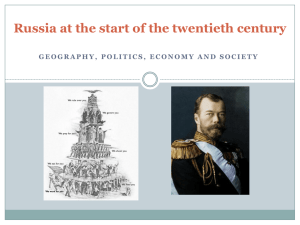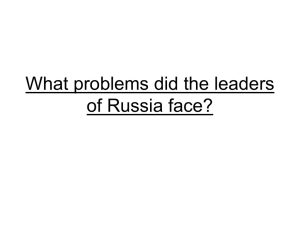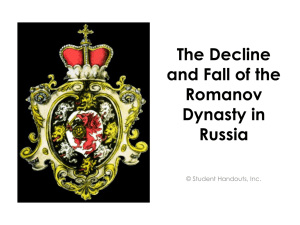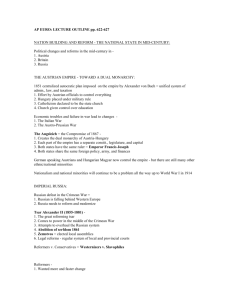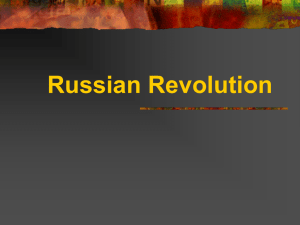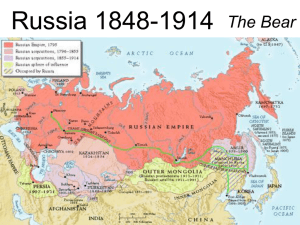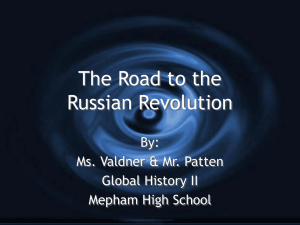16. Russia`s Modernization and Stirrings
advertisement
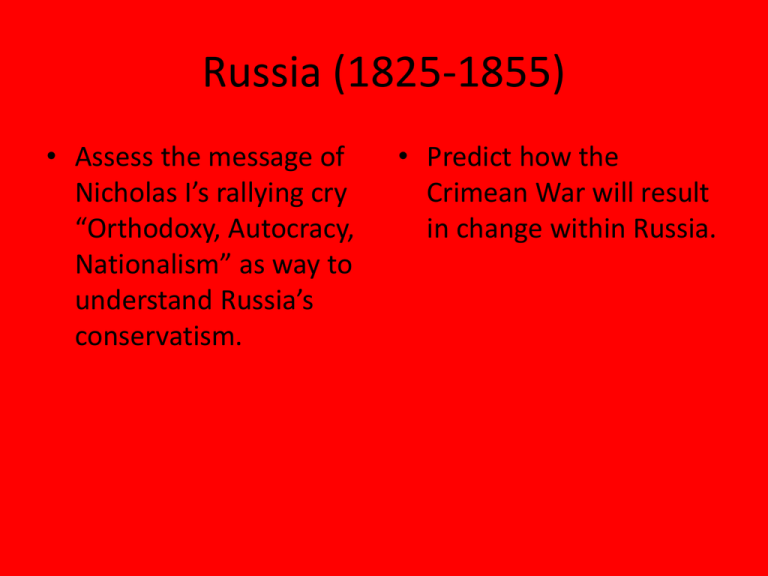
Russia (1825-1855) • Assess the message of Nicholas I’s rallying cry “Orthodoxy, Autocracy, Nationalism” as way to understand Russia’s conservatism. • Predict how the Crimean War will result in change within Russia. Russia (1825—1914) • After the death of Tsar Alexander I, the Decembrist Revolt occurred in 1825 – Under Alexander I, modernization of Russia began and greater freedoms were offered to the people • Nicholas I crushed the Decembrist Revolt and continued autocratic policies – Created the Third Sectionsecret police • “Orthodoxy, Autocracy, Nationality” became rallying cry of Nicholas I’s Russia • CONFLICT: Westernizers wanted Russia to industrialize and set up a constitutional gov’t versus Slavophiles who wanted Russian culture to remain isolated from Europe Russia and the Crimean War • After its poor showing in the Crimean War, people were calling for reform • Nicholas I would not contemplate reform BUT his successor Alexander II knew reform was needed Reform and Repression Alexander II Alexander III Russian Reforms under Alexander II • Emancipation Proclamation of 1861 ended serfdom – positives – serfs gain rights to marry without permission, to buy and sell land, to sue in court and to pursue trades – negatives – serfs had to buy the land from their landlords; usually were given the poorest lands • local government reform – local governments called zemstvos were a district assembly that dealt with local issues like education and social service. • Zemstvos were still dominated by the landed aristocracy, but did provide a glimmer of political freedom Reforms cont’d • judicial reform – included equality before the law, impartial hearings, uniform procedures, judicial independence, and trial by jury • military reform – service requirements lowered from twenty-five to fifteen years and discipline is relaxed slightly • repression in Poland – Poland basically becomes a Russian province under Russian laws and language Alexander II’s assassination • Alexander was unwilling to introduce a written constitution and parliamentary bodies • Ideas of anarchism and populism (communism) began to circulate against Alexander II • A revolutionary organization called the People’s Will assassinated Alexander II in 1881 – Led by Mikhail Bakunin and Alexander Herzen – Dedicated to the overthrow of the autocracy – Wanted a social revolution based on the communal life of Russian peasants Alexander III • Alexander III (r.1881-1894) will enhance repression and attempt to weaken the reforms of his father, Alexander II • autocratic and repressive “Orthodoxy, Autocracy, Nationality” returns as motto of gov’t • strengthened secret police and censorship of the press • Placed a greater importance of traditional values p. 909--911 Industrial Development • What economic successes did Russia experience between 1890—1914? • Identify the figure and industrial reforms Social Unrest • What factors led to the rise of social unrest? Industrial Growth in Russia • Between 1870 and 1900, Russia expanded railroad network significantly • Russian industry prospered throughout the 1890s primarily due to the work of Sergei Witte • Sergei Witte – served as first Russian minister of finance first; wanted to modernize Russian economy through – economic development – protective tariffs – high taxes – Russian currency on gold standard with rest of Europe • steel, iron, and textile industries expand as Trans-Siberian Railroad is completed (1903) • Suppressed organized laboreliminate strikes for industrial progress Unrest in the Cities and Countryside • By 1900, depression had led to high unemployment and industrial shutdowns • social unrest – growth of industry does not improve lives of the peasants, many who have to work on the land of prosperous farmers known as kulaks Nicholas II (r. 1894-1917) • Alexander III died in 1894 • Nicholas II lacked political wit and a firm will to lead Russia – Situation will worsen • The Russian Social Democrats and the Social Revolutionaries began to gain strength in Russia – Both were Marxist Vladimir Lenin – future leader of the communist revolution • led Social Democrats who rejected the German ideas of gradual socialism and called for a revolution • Social Democratic Party split into two: – Lenin’s faction, the majority or Bolsheviks – the moderate faction, the minority or the Mensheviks • wanted to unite workers and peasants to overthrow the tsar (idea came about in 1905, but revolution didn’t occur till 1917) The Revolution of 1905 • https://www.youtube.com/watch?v=-gQ-s8W26Lk • Bloody Sunday – tsar’s troops violently put down a protest leading to ordinary Russians no longer trusting the tsar • worker groups called the soviets, not the tsar, basically control city of St. Petersburg • Nicholas II issues October Manifesto promising a constitutional government – representative body, the Duma, put into place in 1907 – conservative in nature basically kept the power of the tsar in place – Civil liberties were extended to include freedom of speech, assembly, and press – Nicholas II announced he would reorganize his gov’t Factionalism in the Duma • The Duma was convened in 1906, but was plagued by internal factionalism – Monarchists constitutionalists who wanted to maintain the power of tsar vs. Constitutional Democrats who wanted a liberal representative system – improves agricultural production by encouraging individual ownership • By 1907 Russia began a gradual economic recovery that quelled rebellion – Agricultural production was improved • From 1907 to 1914, Nicholas II lacked the leadership needed to guide Russia • Grigory Efimovich Rasputin – became the minister of finance to the tsar because his wife could heal the tsar’s hemophiliac son • Uncouth and strange, tsar’s power is undermined after 1911

